Radiator -- Installation |
| 1. INSTALL FAN SHROUD WITH COOLING FAN |
Install the fan shroud with cooling fan to the radiator with the 2 bolts.
- Torque:
- 11 N*m{107 kgf*cm, 8 ft.*lbf}
 |
| 2. INSTALL RADIATOR ASSEMBLY |
Install the 2 oil cooler hoses with the 2 bolts.
- Torque:
- 5.5 N*m{56 kgf*cm, 49 in.*lbf}
Connect the 2 oil cooler hoses to the radiator.
Install the 4 fan shroud cushions to the cooler condenser.
Set the cooler condenser into the fan shroud.
Install the 2 radiator support lower cushions to the fan shroud.
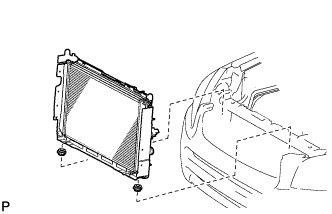 |
Install the radiator with cooler condenser and fan shroud to the lower radiator supports.
| 3. INSTALL UPPER RADIATOR SUPPORT SUB-ASSEMBLY |
Install the upper radiator support with the 4 bolts.
- Torque:
- 31 N*m{316 kgf*cm, 23 ft.*lbf}
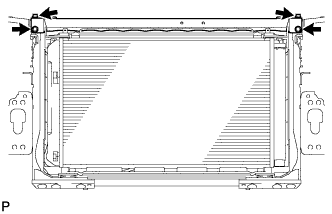 |
| 4. INSTALL NO. 2 FAN SHROUD |
Attach the 2 claws to install the No. 2 fan shroud, and install the 2 bolts.
- Torque:
- 11 N*m{107 kgf*cm, 8 ft.*lbf}
 |
| 5. INSTALL UPPER RADIATOR SUPPORT BRACKET |
Install the brackets with the 2 bolts.
- Torque:
- 19 N*m{194 kgf*cm, 14 ft.*lbf}
 |
| 6. INSTALL NO. 2 WATER BY-PASS HOSE |
Install the No. 2 water by-pass hose to the radiator and radiator reservoir.
- HINT:
- The direction of the hose clamp is indicated in the illustration.
| 7. CONNECT NO. 2 RADIATOR HOSE |
- HINT:
- The direction of the hose clamp is indicated in the illustration.
| 8. CONNECT NO. 1 RADIATOR HOSE |
- HINT:
- The direction of the hose clamp is indicated in the illustration.

| 9. CONNECT OIL COOLER OUTLET HOSE |
| 10. CONNECT OIL COOLER INLET HOSE |
| 11. CONNECT COOLING FAN ECU HARNESS |
Attach the harness with the 3 clamps.
Connect the 2 fan ECU connectors.

| 12. INSTALL NO. 1 WATER BY-PASS PIPE |
Install the No. 1 water by-pass pipe to the upper radiator support with the 2 bolts.
- Torque:
- 5.0 N*m{51 kgf*cm, 44 in.*lbf}
Connect the No. 2 radiator hose to the No. 1 water by-pass pipe.
| 13. INSTALL NO. 5 WATER BY-PASS HOSE |
Install the No. 5 water by-pass hose to the radiator and No. 1 water by-pass pipe.
| 14. INSTALL NO. 1 WATER BY-PASS HOSE |
Install the No. 1 water by-pass hose to the radiator reservoir and No. 1 water by-pass pipe.

| 15. CONNECT HOOD LOCK SWITCH ASSEMBLY |
Connect the hood lock switch assembly with the 3 bolts.
- Torque:
- 8.0 N*m{82 kgf*cm, 71 in.*lbf}
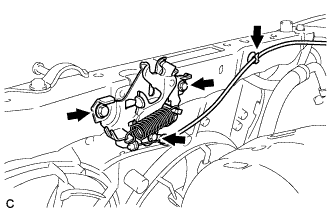 |
Connect the wire to the clamp.
Connect the hood lock switch connector.
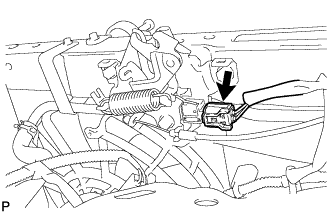 |
| 16. INSTALL RADIATOR GRILLE SUB-ASSEMBLY |
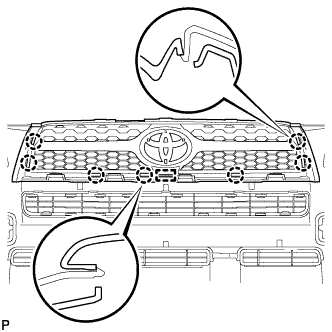 |
Attach the 7 claws and guide to install the radiator grille.
Install the 3 bolts and 3 nuts.
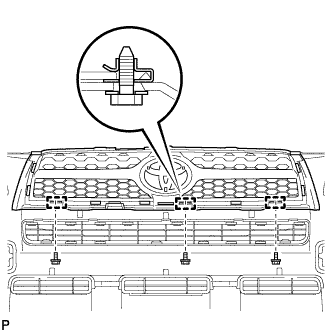 |
| 17. INSTALL BATTERY |
Install the battery and battery insulator.
| 18. INSTALL BATTERY CLAMP SUB-ASSEMBLY |
Attach the hook of the battery clamp to the front battery bracket.
Temporarily tighten the nut and install the bolt.
Adjust the battery clamp position.
Fully tighten the nut and bolt.
- Torque:
- Bolt:
- 17 N*m{170 kgf*cm, 12 ft.*lbf}
- Nut:
- 4.9 N*m{50 kgf*cm, 43 in.*lbf}
 |
Attach the 2 wire harness clamps.
| 19. CONNECT CABLE TO NEGATIVE BATTERY TERMINAL |
| 20. INSTALL RADIATOR SUPPORT OPENING COVER |
Install the cover with the 9 clips.
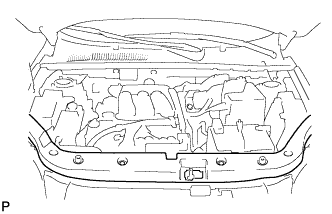 |
| 21. INSTALL V-BANK COVER SUB-ASSEMBLY |
Attach the 3 clips to install the engine cover.
 |
| 22. ADD ENGINE COOLANT |
Tighten the radiator drain cock plug by hand.
Tighten the 2 cylinder block drain cock plugs.
- Torque:
- 13 N*m{130 kgf*cm, 10 ft.*lbf}
Add TOYOTA Super Long Life Coolant (SLLC) to the radiator reservoir filler opening.
Continue adding TOYOTA SLLC until it is filled to the B line at the base of the reservoir's filler neck.
- Standard capacity:
- 9.3 liters (9.8 US qts, 8.2 Imp. qts)
- HINT:
- TOYOTA vehicles are filled with TOYOTA SLLC at the factory. In order to avoid damage to the engine cooling system and other technical problems, only use TOYOTA SLLC or similar high quality ethylene glycol based non-silicate, non-amine, non-nitrite, non-borate coolant with long-life hybrid organic acid technology (coolant with long-life hybrid organic acid technology consists of a combination of low phosphates and organic acids).
- NOTICE:
- Never use water as a substitute for engine coolant.
 |
Squeeze the No. 1 and No. 2 radiator hoses several times by hand, and then check the level of the coolant. If the coolant level drops below the B line, add TOYOTA SLLC to the B line.
Install the radiator reservoir cap.
Start the engine and warm it up until the cooling fan operates. While the cooling fan operates, circulate the coolant for several minutes.
Set the air conditioning as follows while warming up the engine.
Item Specified Condition Manual Air Conditioning System Fan speed: Any setting except OFF Temperature: Toward WARM
Air conditioning switch: OFFAutomatic Air Conditioning System Temperature: Toward MAX
Air conditioning switch: OFFMaintain the engine speed at 2,000 to 2,500 rpm and warm up the engine until the cooling fan operates.
- NOTICE:
- Make sure that some coolant remains in the radiator reservoir.
- Pay attention to the needle of the water temperature meter. Make sure that the needle does not show an abnormally high temperature.
- If there is not enough coolant, the engine may burn out or overheat.
- Immediately after starting the engine, if the radiator reservoir does not have any coolant, perform the following: 1) stop the engine, 2) wait until the coolant has cooled down, and 3) add coolant until the coolant is filled to the B line.
- Run the engine at 2,000 rpm until the coolant level has stabilized.
Squeeze the No. 1 and No. 2 radiator hoses several times to bleed air.
- CAUTION:
- When squeezing the radiator hoses:
- Wear protective gloves.
- Be careful as the radiator hoses are hot.
- Keep your hands away from the radiator fan.
Stop the engine and wait until the coolant cools down to ambient temperature.
Check that the coolant level is between the FULL and LOW lines.
If the coolant level is below the LOW line, repeat all of the procedures above.
If the coolant level is above the FULL line, drain coolant so that the coolant level is between the FULL and LOW lines.
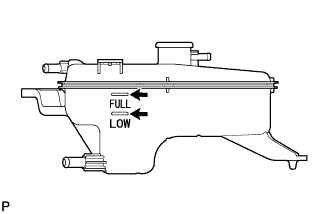 |
| 23. INSPECT FOR COOLANT LEAK |
Remove the radiator reservoir cap.
- CAUTION:
- Do not remove the radiator reservoir cap while the engine and radiator are still hot. Pressurized, hot engine coolant and steam may be released and cause serious burns.
Fill the radiator with coolant, and then attach a radiator cap tester.
 |
Warm up the engine.
Pump the radiator cap tester to 118 kPa (1.2 kgf/cm2, 17.1 psi), and then check that the pressure does not drop.
If the pressure drops, check the hoses, radiator and water pump for leakage.
If there are no signs of external coolant leaks, check the heater core, cylinder block and head.
Reinstall the radiator cap.
| 24. INSTALL NO. 1 ENGINE UNDER COVER |
Install the under cover with the 2 bolts, 4 screw and 12 clips.